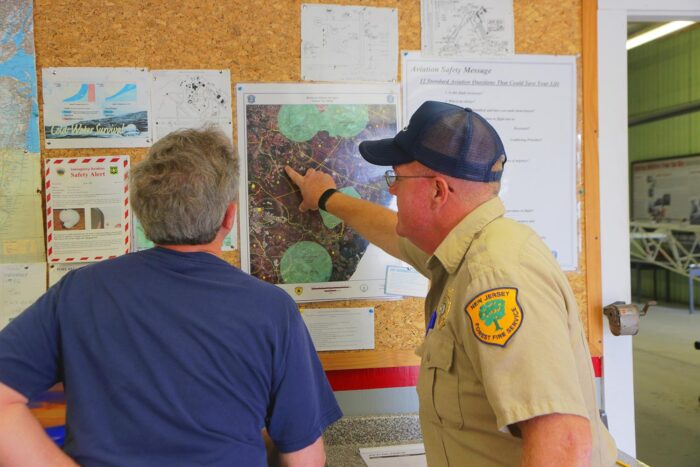
Wildfire sky in the pines by Theresa Law
Policy Notes: August-September 2025
Could the Jones Road Fire have been prevented? Pinelands Commission considers the pros and cons of different forest management methods. Policy Notes are designed to update the public on the activities of the Pinelands Commission, which have been summarized by Pinelands Alliance staff who attend all public meetings of the Commission.
By Heidi YehSeptember 24, 2025
The Plot Thickens Thins
An interesting discussion on forest thinning practices unfolded at September’s meeting of the Pinelands Commission. The subject of debate was a plan to create forest fuel/firebreaks on 2,200 acres within a 12,678-acre parcel containing the Forked River Mountain Wilderness Area. A consulting forester for Ocean County answered questions about their plans to perform mechanical forest thinning, prescribed burning, and fuel breaks to achieve various fire management and ecological goals, such as the creation of Atlantic White Cedar habitat.
Commissioner Lohbauer raised concerns about thinning practices in some treatment zones, citing studies that question whether thinning reliably reduces wildfire risk (see references at the bottom of this post). Critics argue that thinning can open canopies, dry fuels, and accelerate fire spread, but such findings are often highly context-dependent or based on extreme scenarios. While some analyses suggest prescribed burning or home ignition zone defenses may offer more reliable protection, most land managers continue to see thinning—when applied appropriately—as a cornerstone of modern wildfire mitigation.
Discussion turned to the recent Jones Road fire, which burned over 15,000 acres. Commissioner Buzby-Cope asked how fuel breaks might have changed its course. The forester explained that strategically placed north-south breaks would have allowed safer, quicker firefighter access, limiting spread by spot-fires that forced crews to repeatedly retreat to the blacktop road and reposition.
It was interesting to learn how Pinelands Commission policy has changed over time to reflect the latest science. For example, the prevailing wisdom on how to protect the threatened & endangered snake species that are known to reside in this area. Forestry work was once scheduled for winter, when snakes were thought to be safely hibernating. However, heavy machinery sometimes collapsed dens, causing unintended harm. The schedule now favors warmer months (in this plan, April 15-November 15), when snakes are active and able to move away from disturbance. Winter work is still possible, but only by hand, with foresters on foot. Commissioner Lohbauer cautioned about shoulder seasons, when sudden cold snaps can immobilize snakes after they leave their dens, and recommended narrowing the work window.

Working Towards Zero Debris on Zero Magnolia
Pinelands Commission staff continue to pursue a real resolution for damages wrought on nearby wetlands. In early 2024, truckloads of construction debris were dumped on a farm road to “improve” it—filling in the bordering wetlands (owned by “Zero Magnolia”). A year and a half later, much of this debris still remains in place. NJDEP issued a notice of violation shortly after the initial dumping, but has failed to truly hold the polluter accountable since that time. The Pinelands Commission and Pemberton Township have actually taken this matter seriously and are continuing to push for effective enforcement and cleanup of the issue. You can read more about the backstory on this issue on our website.
Top Priority: Create the ‘To-Do’ List!
Pinelands Commission staff have set their workplan for the 2025-2026 fiscal year. You can see the full list of priorities in the meeting minutes on pages 11-20.
The Alliance is pleased to see that artificial turf and plant protections made the list of topics that Commission staff plan to work on this year, hopefully resulting in amendments to the Pinelands Comprehensive Management Plan (CMP). Although a growing number of Pinelands Commission members object to spreading more plastic and other known contaminants from artificial turf fields in the Pinelands, most do not feel like they have explicit legal backing from the CMP. This can be changed by an amendment, but it takes about a year for that whole process to play out.

Budgets for the new year reflect continued underfunding of the Pinelands Commission. While federal funding has remained relatively steady, the state appropriation fails to cover even staff salaries, let alone office operations, research, or public education. Staff deserve recognition for maintaining core duties and advancing updates to the Comprehensive Management Plan despite limited resources. Decades ago, the Commission employed about 20 more people; since then, inflation and budget cuts have steadily reduced capacity. Today’s smaller team continues to deliver essential work, though progress on critical initiatives inevitably comes more slowly under these persistent financial constraints.
Counties move faster than Governors.
Camden County sent a new representative to the Pinelands Commission to be sworn in at the September meeting: a fourth-generation farmer named Gaetano “Guy” Matro. The former representative for the county, John Holroyd, officially stepped down in May of 2025, so his seat was filled within 4 months. Meanwhile, 25 months have elapsed since Ed Lloyd’s passing on August 5, 2023. He was an environmental champion whose seat has yet to be filled on the Pinelands Commission. The Governor is responsible for nominating individuals to fill 7 of the Commission’s 15 seats, but Governor Murphy office has yet to take action, leaving this seat open for over two years now.
Months since the Pinelands Municipal Council last met: 34 months.
Sources Cited by Commissioner Lohbauer on Managing Forests for Fire:
“Why Thinning Forests is Poor Wildfire Strategy,” www.westernwatersheds.org/gw-poor-wildfire-strategy/
“Impacts of Forest Thinning on Wildland Fire Behavior.” Department of Civil and Environmental Engineering, University of California, Irvine, CA, www.mdpi.com/1999-4907/11/9/918
“’Fuel Reduction’ Logging Exacerbates Wildfire Effects and Puts Communities at Greater Risk,” a fact sheet by the John Muir Project that cites 39 studies of forest thinning ranging from 1940 through 2024 demonstrating its ineffectiveness, www.johnmuirproject.org/wp-content/uploads/2024/12/JMP-fact-sheet-thinning-and-fire-29Nov24.pdf
“Despite what the logging industry says, cutting down trees isn’t stopping catastrophic wildfires” www.opb.org/article/2020/10/31/logging-wildfire-forest-management/
Cohen, J.D. (U.S. Forest Service) 2000 “Preventing Disaster: Home ignitability in the wildland-urban interface,” https://research.fs.usda.gov/treesearch/4688
Calkin, D.E., Barrett, K., Cohen, J.D., Finney, M.A., Pyne, S.J., and Quarles, S.L.(co-authored by the U.S. Forest Service), 2023. “Wildland-urban fires aren’t actually a wildfire problem.” PNAS: https://www.pnas.org/doi/full/10.1073/pnas.2315797120
“Prescribed fire as a means of reducing forest carbon emissions in the western United States,” Wiedinmyer, Christine and Hurteau, Matthew D., Environ Sci Technol Journal, 2010 Mar 15; 44(6): 1926-32, https://pubmed.ncbi.nlm.nih.gov/20148581/
